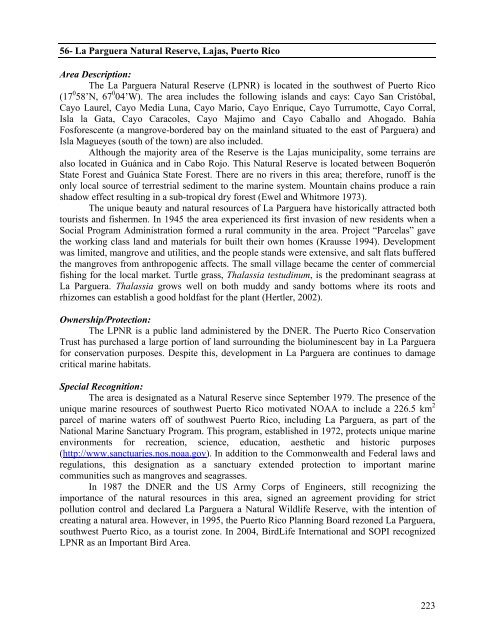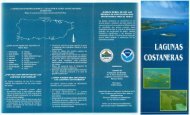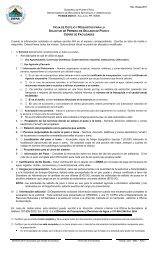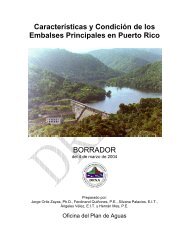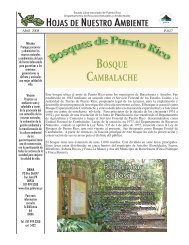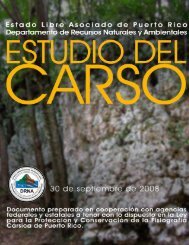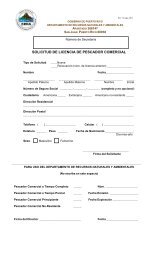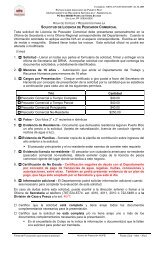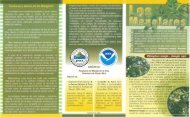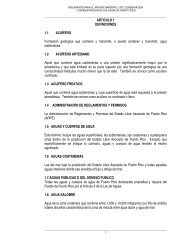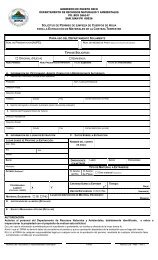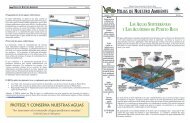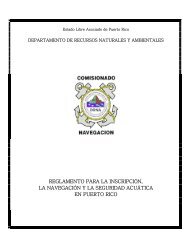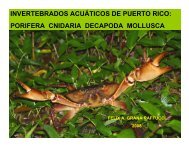Puerto Rico Critical Wildlife Areas - Puerto DRNA - Gobierno de ...
Puerto Rico Critical Wildlife Areas - Puerto DRNA - Gobierno de ...
Puerto Rico Critical Wildlife Areas - Puerto DRNA - Gobierno de ...
Create successful ePaper yourself
Turn your PDF publications into a flip-book with our unique Google optimized e-Paper software.
56- La Parguera Natural Reserve, Lajas, <strong>Puerto</strong> <strong>Rico</strong><br />
Area Description:<br />
The La Parguera Natural Reserve (LPNR) is located in the southwest of <strong>Puerto</strong> <strong>Rico</strong><br />
(17 0 58’N, 67 0 04’W). The area inclu<strong>de</strong>s the following islands and cays: Cayo San Cristóbal,<br />
Cayo Laurel, Cayo Media Luna, Cayo Mario, Cayo Enrique, Cayo Turrumotte, Cayo Corral,<br />
Isla la Gata, Cayo Caracoles, Cayo Majimo and Cayo Caballo and Ahogado. Bahía<br />
Fosforescente (a mangrove-bor<strong>de</strong>red bay on the mainland situated to the east of Parguera) and<br />
Isla Magueyes (south of the town) are also inclu<strong>de</strong>d.<br />
Although the majority area of the Reserve is the Lajas municipality, some terrains are<br />
also located in Guánica and in Cabo Rojo. This Natural Reserve is located between Boquerón<br />
State Forest and Guánica State Forest. There are no rivers in this area; therefore, runoff is the<br />
only local source of terrestrial sediment to the marine system. Mountain chains produce a rain<br />
shadow effect resulting in a sub-tropical dry forest (Ewel and Whitmore 1973).<br />
The unique beauty and natural resources of La Parguera have historically attracted both<br />
tourists and fishermen. In 1945 the area experienced its first invasion of new resi<strong>de</strong>nts when a<br />
Social Program Administration formed a rural community in the area. Project “Parcelas” gave<br />
the working class land and materials for built their own homes (Krausse 1994). Development<br />
was limited, mangrove and utilities, and the people stands were extensive, and salt flats buffered<br />
the mangroves from anthropogenic affects. The small village became the center of commercial<br />
fishing for the local market. Turtle grass, Thalassia testudinum, is the predominant seagrass at<br />
La Parguera. Thalassia grows well on both muddy and sandy bottoms where its roots and<br />
rhizomes can establish a good holdfast for the plant (Hertler, 2002).<br />
Ownership/Protection:<br />
The LPNR is a public land administered by the DNER. The <strong>Puerto</strong> <strong>Rico</strong> Conservation<br />
Trust has purchased a large portion of land surrounding the bioluminescent bay in La Parguera<br />
for conservation purposes. Despite this, <strong>de</strong>velopment in La Parguera are continues to damage<br />
critical marine habitats.<br />
Special Recognition:<br />
The area is <strong>de</strong>signated as a Natural Reserve since September 1979. The presence of the<br />
unique marine resources of southwest <strong>Puerto</strong> <strong>Rico</strong> motivated NOAA to inclu<strong>de</strong> a 226.5 km 2<br />
parcel of marine waters off of southwest <strong>Puerto</strong> <strong>Rico</strong>, including La Parguera, as part of the<br />
National Marine Sanctuary Program. This program, established in 1972, protects unique marine<br />
environments for recreation, science, education, aesthetic and historic purposes<br />
(http://www.sanctuaries.nos.noaa.gov). In addition to the Commonwealth and Fe<strong>de</strong>ral laws and<br />
regulations, this <strong>de</strong>signation as a sanctuary exten<strong>de</strong>d protection to important marine<br />
communities such as mangroves and seagrasses.<br />
In 1987 the DNER and the US Army Corps of Engineers, still recognizing the<br />
importance of the natural resources in this area, signed an agreement providing for strict<br />
pollution control and <strong>de</strong>clared La Parguera a Natural <strong>Wildlife</strong> Reserve, with the intention of<br />
creating a natural area. However, in 1995, the <strong>Puerto</strong> <strong>Rico</strong> Planning Board rezoned La Parguera,<br />
southwest <strong>Puerto</strong> <strong>Rico</strong>, as a tourist zone. In 2004, BirdLife International and SOPI recognized<br />
LPNR as an Important Bird Area.<br />
223


